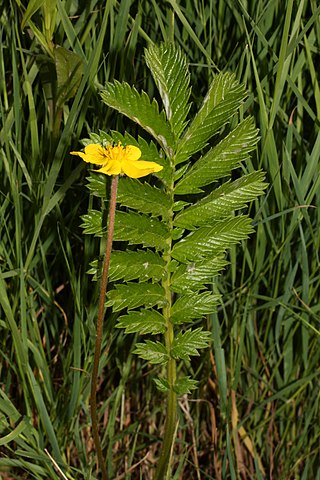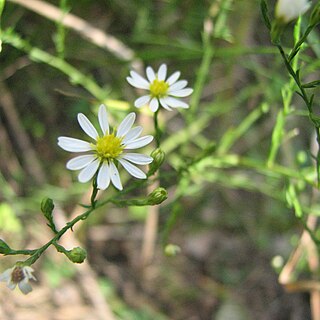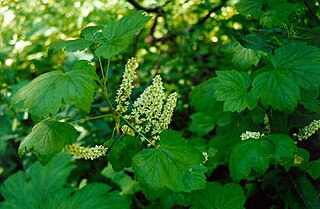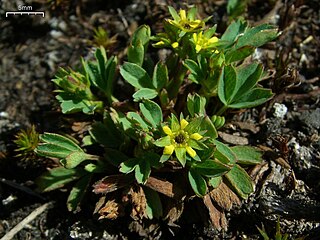
The rose subfamily Rosoideae consists of more than 850 species, including many shrubs, perennial herbs, and fruit plants such as strawberries and brambles. Only a few are annual herbs.

Potentilla is a genus containing over 300 species of annual, biennial and perennial herbaceous flowering plants in the rose family, Rosaceae.

Argentina anserina is a perennial flowering plant in the rose family, Rosaceae. It is known by the common names silverweed, common silverweed or silver cinquefoil. It is native throughout the temperate Northern Hemisphere, often on river shores and in grassy habitats such as meadows and road-sides. The plant was originally placed in the genus Potentilla by Carl Linnaeus in his Species plantarum, edition 1, (1753) but was reclassified into the resurrected genus Argentina by research conducted in the 1990s. The reclassification remains controversial and is not accepted by some authorities. It is a species aggregate which has frequently been divided into multiple species.

Tiarella, the foamflowers, is a genus of flowering plants in the family Saxifragaceae. The generic name Tiarella means "little turban", which suggests the shape of the seed capsules. Worldwide there are seven species, one each in eastern Asia and western North America, plus five species in eastern North America. As of October 2022, the taxonomy of Tiarella in eastern North America is in flux.

Cardamine concatenata, the cutleaved toothwort, crow's toes, pepper root or purple-flowered toothwort, is a flowering plant in the family Brassicaceae. It is a perennial woodland wildflower native to eastern North America.

Symphyotrichum lateriflorum is a species of flowering plant in the aster family (Asteraceae). Commonly known as calico aster, starved aster, and white woodland aster, it is native to eastern and central North America. It is a perennial and herbaceous plant that may reach heights up to 120 centimeters and widths up to 30 centimeters.

Orbexilum, commonly called leather-root, is a genus of flowering plants in the legume family (Fabaceae). They are native to North America, where they are found in the United States and Mexico, south to Chiapas.

Symphyotrichum depauperatum, commonly known as serpentine aster or starved aster, is a rare species in the family Asteraceae adapted to serpentine barrens, an ecosystem with a high concentration of toxic metals in the soil. It has been found in Pennsylvania, Maryland, and on some diabase glades in North Carolina. It grows to 50 centimeters and has white ray florets surrounding a center of yellow disk florets.

Ribes hudsonianum is a North American species of currant, known by the common name northern black currant.

Potentilla villosa is a species of flowering plant in the rose family, Rosaceae. Its common names include villous cinquefoil, northern cinquefoil, and hairy cinquefoil. It is native to northwestern North America, where its distribution extends from Alaska to Alberta to Oregon. There are records from eastern Asia.
Arisaema quinatum is a species of flowering plant in the arum family Araceae. It is a member of the Arisaema triphyllum complex, a group of closely related taxa in eastern North America. The specific name quinatum means "divided into five lobes", a reference to its characteristic leaves. It is commonly known as the southern Jack-in-the-pulpit but some refer to it as Preacher John.

Symphyotrichum oolentangiense, commonly known as skyblue aster and azure aster, is a species of flowering plant in the family Asteraceae native to eastern North America.

Symphyotrichum shortii, commonly called Short's aster, is a species of flowering plant in the family Asteraceae. It is native to North America, where it is primarily found in interior areas east of the Mississippi River. Its natural habitat is in thin rocky soils of woodlands and thickets often around limestone bluffs. It is common throughout much of its range, although it is generally restricted to intact natural communities.

Sibbaldia is a genus of flowering plants of the family Rosaceae, with a circumpolar distribution, including the high Arctic. The type species is Sibbaldia procumbens. It is also in the Rosoideae subfamily.

Symphyotrichum patens, commonly known as late purple aster or spreading aster, is a perennial, herbaceous plant found in the eastern United States.

Potentilla nivea, called the snow cinquefoil, snowy cinquefoil, and villous cinquefoil, is a species of flowering plant in the genus Potentilla, native to Subarctic Asia, North America, Greenland, and Europe, and the Subalpine Rockies and Alps. It comes in many ploidy levels; 2x, 3x, 4x, 5x, 6x, 7x, 8x and 10x.

Sibbaldia cuneata, the cuneate cinquefoil or five finger cinquefoil, is a species of flowering plant in the family Rosaceae, native to Afghanistan, Pakistan, the Himalaya, China, and Taiwan. As its synonym Potentilla cuneata it has gained the Royal Horticultural Society's Award of Garden Merit.

Dasiphora fruticosa var. veitchii is a flowering plant in the family Rosaceae, native to Sichuan and Yunnan in China. It was first described as the species Potentilla veitchii by Ernest Henry Wilson in 1911, after he had earlier introduced it into gardens in the United Kingdom. Its scientific name and status have varied, and remained "unresolved" according to the Royal Horticultural Society as of May 2022. In horticulture, it may also be found under the names Potentilla davurica var. veitchii and Potentilla fruticosa var. veitchii. It is cultivated as an ornamental flowering shrub.

Drymocallis fissa, the bigflower cinquefoil, also known as the leafy cinquefoil, leafy drymocallis, or wood beauty, is a small plant also sometimes classified as Potentilla fissa. It is a herbaceous plant with a thick taproot known for its moderately hairy leaves, redish leaf stems, and relatively large yellow flowers. It is native to foothills and lower mountains the Rocky Mountain region in the western United States.



















